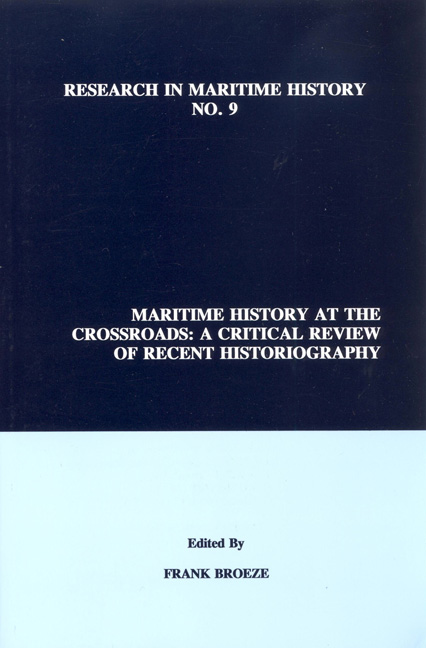Book contents
- Frontmatter
- Contents
- About the Editor
- Introduction
- Contributors
- “Maritime History in Australia”
- “The Enterprising Canadians: An Assessment of Canadian Maritime History since 1975”
- “The Historiography of Maritime China since c. 1975”
- “Danish Maritime History, 1976-1992: A Review”
- “German Maritime Historical Research since 1970: A Critical Survey”
- “The Maritime Historiography of Greece in Recent Decades”
- “Ibero-American Maritime History: Recent Advances in Research, 1975-1994”
- “Indian Maritime Historiography: West Coast Merchants in a Globalizing Economy”
- “Recent Developments in the Historiography of Maritime History in the Netherlands”
- “The Ottoman Empire: Recent Research on Shipping and Shipbuilding in the Sixteenth to Nineteenth Centuries”
- “The Progress of Maritime History in Spain since 1975”
- “Oceanic Historiography: The American Dimension”
“The Historiography of Maritime China since c. 1975”
from Contributors
- Frontmatter
- Contents
- About the Editor
- Introduction
- Contributors
- “Maritime History in Australia”
- “The Enterprising Canadians: An Assessment of Canadian Maritime History since 1975”
- “The Historiography of Maritime China since c. 1975”
- “Danish Maritime History, 1976-1992: A Review”
- “German Maritime Historical Research since 1970: A Critical Survey”
- “The Maritime Historiography of Greece in Recent Decades”
- “Ibero-American Maritime History: Recent Advances in Research, 1975-1994”
- “Indian Maritime Historiography: West Coast Merchants in a Globalizing Economy”
- “Recent Developments in the Historiography of Maritime History in the Netherlands”
- “The Ottoman Empire: Recent Research on Shipping and Shipbuilding in the Sixteenth to Nineteenth Centuries”
- “The Progress of Maritime History in Spain since 1975”
- “Oceanic Historiography: The American Dimension”
Summary
Maritime historians should welcome the recent upsurge of scholarship on China's maritime past. Drawing on the rich output of maritime literature since about 1975, this chapter offers a general overview of Chinese maritime history. Within this broad remit, I have three more specific objectives. First, I want to assess briefly the state of Chinese maritime history. The major issues include the international nature of research in Chinese maritime history, new archives and recent research in shipping and shipbuilding, maritime trade, ports and port cities, maritime communities, and cooperation among institutions, regional and international. Second, I would like to focus on two major case studies in Chinese and Japanese merchant shipping which have received considerable historiographie attention: Mitsubishi-Nippon Yusen Kaisha (NYK) and China Merchants’ Steam Navigation Company. Third, I shall conclude with some suggestions on future directions of maritime history in East Asia which should be of interest to Chinese historians, policy analysts, and students of comparative maritime history.
Recent Upsurge of Research in Chinese Maritime History
Three years ago, Pin-tsun Chang examined the importance of Chinese maritime endeavours under three headings - shipping technology, trade and overseas Chinese — in the International Journal of Maritime History This review builds on Chang's important essay to give a more systematic and comprehensive survey of the state of Chinese maritime history over the last two decades.
Dr. Chang notes that the height of traditional shipping technology in China was reached between 1000 AD and 1400 AD with the invention of “the stern post-rudder, marine compass, watertight compartments… mat and batten sails” and the traditional junk. He argues that this technology led to the seven voyages of Cheng Ho (1405-1433), after which Chinese shipping technology stagnated. In his review of the literature on overseas Chinese, Chang contends that the immigrants in Southeast Asia controlled almost all regional trade. Chang's most significant point is the idea that “change in the composition of the Chinese immigrant flow reflects the decline of a Chinese technological advantage,” a point deduced from the fact that before 1850 most Chinese emigrants were traders or skilled workers, while thereafter most were unskilled. The West had usurped China's dominant maritime role in East Asia and even the adoption of some western technology could not reverse the situation. Generally, I agree with Chang's argument.
- Type
- Chapter
- Information
- Maritime History at the CrossroadsA Critical Review of Recent Historiography, pp. 53 - 80Publisher: Liverpool University PressPrint publication year: 1995



